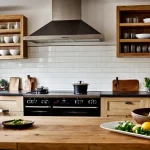Determining Your Kitchen Needs and Lifestyle
When selecting kitchen appliances, a thorough lifestyle assessment is essential. Start by evaluating your personal cooking habits: How often do you cook? Do you prefer quick meals, elaborate recipes, or baking? Understanding your culinary style helps you pinpoint which appliances will be most useful.
Next, consider your household size and available kitchen space. A larger family may require more versatile or higher-capacity appliances, while a smaller household might focus on compact models. Kitchen appliance selection should factor in both storage capacity and countertop space.
Have you seen this : How can you score the best UK kitchen appliance discounts?
Distinguishing between essential and optional appliances depends on your routines. For example, if you rarely bake, a stand mixer may be optional, whereas a quality blender might be indispensable for smoothie lovers. Prioritizing appliances tailored to your lifestyle avoids clutter and optimizes efficiency.
By focusing on these elements—frequency of cooking, kitchen size, and routine needs—you can make informed decisions in your kitchen appliance selection, ensuring each item supports your day-to-day activities effectively.
Also read : How to find the best UK kitchen deals for first-time buyers?
Key Factors to Consider When Choosing Kitchen Appliances
Selecting kitchen appliances involves focusing on appliance features that align with your specific cooking habits and lifestyle. Look for innovations like smart controls, multi-function settings, and easy-to-clean surfaces. These features can make everyday tasks more efficient and enjoyable.
Another essential factor is brand reputation. Established brands often offer better durability and customer support. Checking reviews and ratings provides insight into reliability and overall satisfaction, helping you avoid costly replacements.
Energy efficiency is increasingly important. Appliances with high energy efficiency ratings save money over time and reduce environmental impact. Comparing energy consumption not only helps in lowering utility bills but also supports sustainable living.
When making an appliance comparison, consider how each model meets your needs in practical terms. Balance features, brand trustworthiness, and energy use rather than focusing solely on price. This approach ensures you invest in appliances that deliver value, performance, and longevity.
By prioritizing these factors—appliance features, brand reputation, energy efficiency—and thoughtful appliance comparison, you can confidently choose kitchen appliances tailored to your household while maximizing efficiency and satisfaction.
Budgeting and Cost Considerations
When deciding on an appliance, appliance pricing plays a crucial role in achieving the right balance between affordability and performance. Prices for common appliances can vary widely depending on the brand, features, and energy efficiency. For instance, a basic refrigerator may be more affordable upfront, but investing in a higher-end model with energy-saving technology often leads to long-term savings.
A clear appliance cost comparison helps reveal not only the initial cost but also factors like installation fees, maintenance, and operational expenses. These add-ons can significantly impact the total expenditure over the appliance’s lifetime. Considering durability is essential, as a slightly higher purchase price may pay off through fewer repairs and a longer lifespan.
Understanding the full financial scope promotes smarter choices and more value for money. For example, budgeting beyond the sticker price avoids surprises, ensuring the appliance fits both your current financial plan and future needs. Being informed about all these cost factors empowers you to select an appliance that balances quality with cost-efficiency.
Making Informed Decisions with User Reviews and Expert Recommendations
When choosing home appliances, user reviews provide invaluable firsthand insights into real performance and reliability. Verified customer feedback often highlights strengths and weaknesses unnoticed in official specs. For example, users frequently mention how an appliance handles daily use or how durable it remains after months or years.
Alongside reviews, expert appliance recommendations are a trusted resource. Professionals conduct detailed testing and provide balanced assessments, often comparing models side-by-side. These expert guides help decode complex features and focus on what truly matters to consumers, such as energy efficiency or noise levels.
Real-life appliance examples and testimonials add another layer of understanding. These narratives offer perspective on how appliances perform in various household scenarios, revealing practical benefits and potential limitations. It’s a blend of user reviews, expert input, and lived experiences that creates a comprehensive picture.
This multifaceted approach empowers consumers to make well-informed decisions, minimizing purchase regrets. By combining authentic experiences with professional advice, you gain clarity and confidence—keys to choosing the right appliance for your unique needs.
Final Checklist for Selecting the Best Kitchen Appliances
When it comes to appliance selection checklist, having a clear step-by-step guide is essential to avoid costly mistakes. Start by creating a personal appliance priority list. Identify which appliances you use most frequently and determine the features that matter most—whether it’s energy efficiency, smart connectivity, or size. This list keeps your needs front and center during the selection process.
Next, systematically use the checklist to match your requirements to available options. Compare essential factors such as power consumption, user ratings, and warranty coverage. This ensures you don’t overlook critical details, helping you select appliances that align perfectly with your lifestyle and kitchen habits.
Finally, pay careful attention to measurements, compatibility, and integration with existing appliances. Accurate kitchen planning requires verifying appliance dimensions to fit cabinets, ensuring electrical outlets match specifications, and confirming aesthetics harmonize with your kitchen’s design. Proper integration not only enhances functionality but also streamlines your kitchen workflow, creating a cohesive culinary space you’ll enjoy every day.

